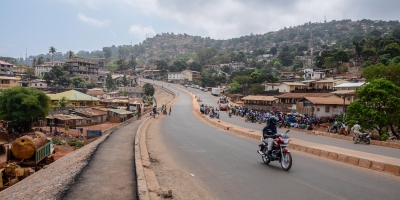
The capital of Sierra Leone is Freetown, which was founded 1787. Freetown has been the capital since 1961. Sierra Leone is bordered on the north and east by Guinea, on the south by Liberia, and on the west by the Atlantic Ocean.
The country can be divided into four distinct physical regions: the coastal swamp, the Sierra Leone Peninsula, the interior plains, and the interior plateau and mountain region. The coastal swamp region extends along the Atlantic for about 200 miles (320 km). It is a flat, low-lying, and frequently flooded plain that is between 5 and 25 miles (8 and 40 km) wide and is composed mainly of sands and clays. Its numerous creeks and estuaries contain mangrove swamps. Sandbars, generally separated by silting lagoons, sometimes form the actual coast. The Sierra Leone Peninsula, which is the site of Freetown, is a region of thickly wooded mountains that run parallel to the sea for about 25 miles (40 km). The Peninsula Mountains rise from the coastal swamps and reach some 2,900 feet (880 metres) at Picket Hill.
Inland from the coastal plain is the interior plains region. In the north it comprises featureless seasonal swamps known as “Bolilands” (boli being a Temne word for those lands that are flooded in the rainy season and dry and hard in the dry season and on which only grass can grow). In the south the plains comprise rolling wooded country where isolated hills rise abruptly to more than 1,000 feet (300 metres). The interior contains a variety of landforms ranging from savanna-covered low plains to rocky scarp and hill country. The interior plateau and mountain region, encompassing roughly the eastern half of the country, is composed mainly of granite with a thick laterite (iron-bearing) crust; to the west it is bounded by a narrow outcrop of mineral-bearing metamorphic rocks known as the Kambui Schists. Rising above the plateau are a number of mountain masses; in the northeast the Loma Mountains are crowned by Mount Loma Mansa (Mount Bintimani) at 6,391 feet (1,948 metres), and the Tingi Mountains rise to 6,080 feet (1,853 metres) at Sankanbiriwa Peak. Numerous narrow inland valley swamps associated with the river systems occur in this region.
Credit : Britannica
Picture Credit : Google
Leave a Reply